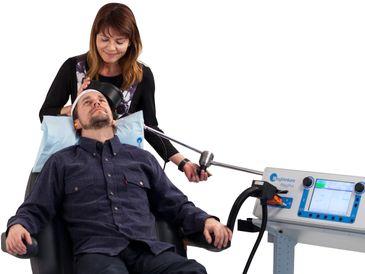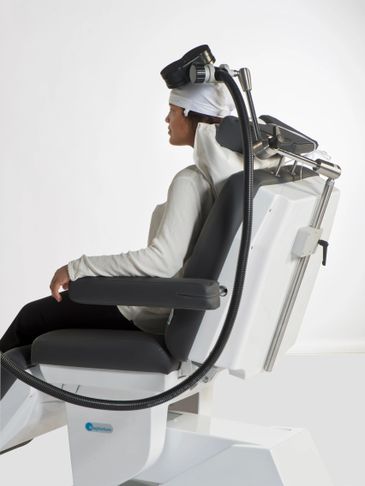Austin Family Psychiatry is now offering TMS Therapy

MagVenture TMS
MagVenture TMS
TMS Therapy is non-invasive, FDA approved and does not require anesthesia. Typically, one treatment is given per day, five times per week, over a period of four to six weeks. MagVenture TMS is offered as Express TMS (theta burst stimulation) which lasts 3 minutes or as standard TMS, lasting 19-37 minutes.

The procedure
MagVenture TMS
The patient sits in a chair in a relaxed position. When the magnetic pulses are delivered, a clicking sound is heard and a tapping sensation is felt on head. Many patients are able to watch television or read during the treatment and patients should be able to resume their daily activities right after treatment.

ELECTROMAGNETIC COIL
ELECTROMAGNETIC COIL
The electromagnetic coil is placed against the patient's scalp near the forehead. The electromagnet painlessly delivers a magnetic pulse that stimulates nerve cells in the region of the brain involved in mood control.
MagVenture TMS Therapy
What is TMS?
Transcranial magnetic stimulation (TMS) is a non-invasive treatment where magnetic pulses are delivered through a magnetic coil to stimulate nerve cells in the part of the brain controlling mood. TMS has been recommended by the American Psychiatric Association (APA) since 2010 and FDA cleared for the treatment of treatment-resistant major depressive disorder (MDD) since 2008 and obsessive compulsive disorder (OCD) since 2018. TMS is typically used when standard treatments such as therapy, medication and self-help techniques have proved ineffective or the side effects from medications are too severe. At this time, we are offering TMS for MDD only.
What are off-label protocols?
Although there is overwhelming scientific evidence that TMS Therapy is being successfully used to treat a wide range of other mental health disorders and illnesses globally, the FDA has only cleared TMS Therapy for MDD and OCD. When TMS Therapy is administered for treatment of other health conditions which are not currently cleared by the FDA, it is described as “off-label”. Physicians and leading hospitals globally are using TMS to successfully treat:
- ADD/ADHD
- PTSD
- Chronic Pain
- Substance Abuse
- Anxiety Disorders
- Panic Disorder
- Eating Disorders
How long is a TMS procedure?
TMS Therapy involves a series of treatment sessions, which vary in length and duration. Typically, one treatment is given per day, five times per week, over a period of four to six weeks. MagVenture TMS is offered as Express TMS (theta burst stimulation) which lasts 3 minutes or as standard TMS, lasting 19-37 minutes.
What does TMS feel like?
The patient sits in a chair in a relaxed position. When the magnetic pulses are delivered, a clicking sound is heard and a tapping sensation is felt on head. Many patients are able to watch television or read during the treatment and patients should be able to resume their daily activities right after treatment.
Are there any side effects to TMS Therapy?
TMS treatment is without the side effects typically experienced with antidepressants and other psychotropic medications. TMS may, for some, cause headache, discomfort at the site of stimulation, nausea, facial twitching or mania. The most serious side effect is induction of a seizure but this is rare (<0.1 %). It should be noted that TMS Therapy is a medical procedure and any side effects experienced during or after receiving the treatment as well as a history of seizures should be reported to the physician.
Who will benefit the most?
Existing evidence to date suggests that patients who are less treatment-resistant respond better to TMS than those who are highly treatment-resistant. However, there is much yet to be learned about particular variables that may impact the response to TMS Therapy. Researchers are presently conducting clinical studies to evaluate who will benefit the most from this treatment. For example, there is a lot of interest in evaluating whether TMS given with antidepressant medications is more effective than TMS alone. Per the world's largest TMS trial to date, 49% of patients responded to TMS and 32% achieved full remission (after failing a minimum of two antidepressants). Comparatively, for 3rd level antidepressants, the response rate is 17% and remission rate is 14%.
Who cannot get TMS Therapy?
Patients who have some kind of non-removable metal in their head (exception of braces or dental fillings) should not receive TMS. Failure to comply with this can heat up the object, move the object from a location or cause serious injury or death. The following is a list of metal implants that can prevent a patient from receiving TMS:
- Aneurysm clips or coils
- Stents in the neck or brain
- Deep brain stimulators
- Electrodes to monitor brain activity
- Metallic implants in your ears and eyes
- Shrapnel or bullet fragments in or near the head
- Facial tattoos with metallic or magnetic-sensitive ink
- Other metal devices or object implanted in or near the head
How much will TMS cost the patient?
We accept Blue Cross Blue Shield (BCBS) and Aetna. Prior authorization is required. Off-label protocols are not covered by insurance. If you are a self-pay patient, please call us for pricing and we will work with you to deliver the best patient care at an affordable price.
TMS in short:
-TMS: Transcranial Magnetic Stimulation
-Series of pulsed magnetic stimuli to brain
-FDA cleared for treatment of MDD and OCD
-Non-invasive treatment- no anesthesia required
-Free from common antidepressant side effects such as weight gain and sexual dysfunction
-Most common side effects from TMS are headache and nausea
-Does not affect cognitive function
-May be used with or without antidepressants (determined by physician)
-For use in outpatient settings
-Maintenance treatment if needed
For a better understanding of TMS, please check out the links, video and pictures below. If you have any questions, please reach out to officemanager@austinfamilypsychiatry.com.

TMS
Are you not responding to antidepressants? TMS Therapy might be the solution for you.
TMS Video Presentation
Comparing the healthy brain (with neurons firing) and depressed brain (with neurons not firing)
Dorsolateral prefrontal cortex (DLPFC)
Dorsolateral prefrontal cortex (DLPFC)
Dorsolateral prefrontal cortex (DLPFC)

The coil targeting the DLPFC
Dorsolateral prefrontal cortex (DLPFC)
Dorsolateral prefrontal cortex (DLPFC)

Copyright © 2022 Austin Family Psychiatry - All Rights Reserved.
The content on all websites associated with Austin Family Psychiatry, including, but not limited to, the text, graphics, images, links, and other materials are for informational purposes only. The content of this website is not intended to be a substitute for professional medical advice, diagnosis, or treatment. Always seek the advice of your qualified healthcare provider. Reliance on any information provided herein is solely at your own risk. Austin Family Psychiatry is not responsible for the content or claims of external websites.